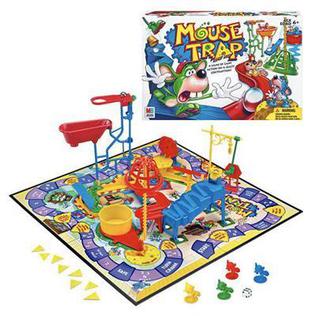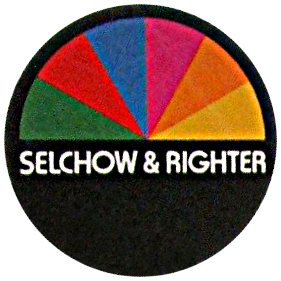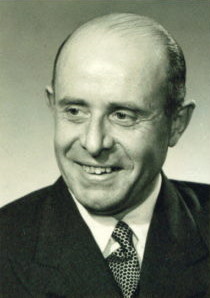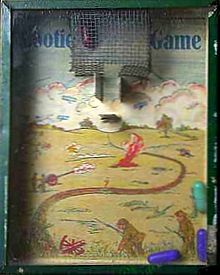
A frisbee, also called a flying disc or simply a disc, is a gliding toy or sporting item that is generally made of injection-molded plastic and roughly 20 to 25 centimetres in diameter with a pronounced lip. It is used recreationally and competitively for throwing and catching, as in flying disc games. The shape of the disc is an airfoil in cross-section which allows it to fly by reducing the drag and increasing lift as it moves through the air, compared to a flat plate. Spinning the disc imparts a stabilizing gyroscopic force, allowing it to be both aimed with accuracy and thrown for distance.

Candy Land is a simple racing board game created by Eleanor Abbott and published by Milton Bradley in 1948. The game requires no reading and minimal counting skills, making it suitable for young children. No strategy is involved as players are never required to make choices; only following directions is required. About one million copies per year are sold.

A hula hoop is a toy hoop that is twirled around the waist, limbs or neck. It can also be wheeled along the ground like a wheel with careful execution and practice. They have been used by children and adults since at least 500 BC. The modern hula hoop was inspired by Australian bamboo hoops. Common lore posits the creators of the plastic hoop witnessed Australian children playing with bamboo hoops while driving past in an automobile. The new plastic version was popularized in 1958 by the Wham-O toy company and became a fad.
Betty Spaghetty was a bendable rubber doll from the Ohio Art Company. She is portrayed as a fun-loving teenager or preteen. She has two best friends named Zoe and Hannah and a younger sister. Her features include rubbery hair used to let children make different hairstyles and changeable hands, feet, shoes, etc. The doll was targeted at girls ages 4 and up. Some models came with accessories, such as a cell phone, a laptop computer, and in-line skates.

Alfred Carlton Gilbert was an American inventor, athlete, magician, toy maker and businessman. As the founder of A. C. Gilbert Company, Gilbert was known for inventing the Erector Set and American Flyer Trains.

Don't Break the Ice is a children's tabletop game for two to four players ages 3 and up. First marketed by Schaper Toys in 1968, the game was sold to Hasbro subsidiary Milton Bradley in 1986. It is still in production, and special editions were released in conjunction with the films Frozen (2013) and Frozen II (2019).

Mouse Trap is a board game first published by Ideal in 1963 for two to four players. It is one of the first mass-produced three-dimensional board games. Players at first cooperate to build a working mouse trap in the style of a Rube Goldberg machine. Then, players turn against each other to trap opponents' mouse-shaped game pieces.
Rock 'Em Sock 'Em Robots is a two-player action toy and game designed by Marvin Glass and Associates and was first manufactured by the Marx toy company in 1964. It features two dueling robot boxers, Red Rocker and Blue Bomber, mechanically manipulated by the players, and the game is won when one player knocks the opposing robot's head up and off the shoulders. The 2000s version of the game by Mattel features physically smaller robots.
A children's song may be a nursery rhyme set to music, a song that children invent and share among themselves or a modern creation intended for entertainment, use in the home or education. Although children's songs have been recorded and studied in some cultures more than others, they appear to be universal in human society.

A fortune teller is a form of origami used in children's games. Parts of the fortune teller are labelled with colors or numbers that serve as options for a player to choose from, and on the inside are eight flaps, each concealing a message. The person operating the fortune teller manipulates the device based on the choices made by the player, and finally one of the hidden messages is revealed. These messages may purport to answer questions, or they may be activities that the player must perform.

Selchow and Righter was a 19th- and 20th-century game manufacturer best known for the games Parcheesi and Scrabble. It was based in Bay Shore, New York.

John Rosemond is an American columnist, public speaker and author on parenting, with 15 books on the subject. His ideas revolve around authority for parents and discipline for children. He sometimes collaborates with PragerU as researcher and spokesperson.
The Larami Corporation was a toy company established by David W. Ring in Philadelphia, Pennsylvania, in 1959. It produced licensed toys based on movies and television shows. Often low-quality, these were manufactured in Hong Kong and Japan for sale on grocery store toy aisle racks for under a dollar.

Head lice infestation, also known as pediculosis capitis, is the infection of the head hair and scalp by the head louse. Itching from lice bites is common. During a person's first infection, the itch may not develop for up to six weeks. If a person is infected again, symptoms may begin much more quickly. The itch may cause problems with sleeping. Generally, however, it is not a serious condition. While head lice appear to spread some other diseases in Africa, they do not appear to do so in Europe or North America.

Schaper Toys, or W.H. Schaper Mfg. Co., Inc. as it was originally known, was a game and toy company founded in 1949 by William Herbert Schaper in Robbinsdale, Minnesota. "Herb" Schaper published a variety of games but was best known for having created the children's game, Cootie. In 1971, the company was sold to Kusan, Inc., and began operating as Schaper Toys, a subsidiary of Kusan, Inc. In 1986, Schaper Toys was acquired by Tyco Toys, which sold the rights to Cootie and three other of the company's best-known games to the Milton Bradley Company. These games are still being sold.

Mystery Date is a board game from the Milton Bradley Company released in 1965, conceived by Marvin Glass and created by Henry Stan. Marketed to girls 6 to 14 years of age, it has been reissued in 1970, 1999, and 2005. It is popularly referenced as a trope in TV and film.
Tim Walsh is an American game inventor, writer and former sportsman.
Milton Martin Levine was an American entrepreneur who was the co-founder of Uncle Milton Toys.

Hilary "Harry" Fisher Page was an English toy maker and inventor of Self-Locking Building Bricks, the predecessor of Lego bricks. He founded the Kiddicraft toy company.

The ancient Romans had a variety of toys and games. Children used toys such as tops, marbles, wooden swords, kites, whips, seesaws, dolls, chariots, and swings. Gambling and betting were popular games in ancient Rome. Legislation heavily regulated gambling; however, these laws were likely not enforced. Tali, Terni lapilli, Duodecim Scripta, and Ludus latrunculorum were all popular games in ancient Rome. They were similar to poker, tic-tac-toe, backgammon, and chess respectively. Nine men's morris may also have been a popular game in ancient Rome. Roman children also played games simulating historical battles and could pretend to be important government officials.















